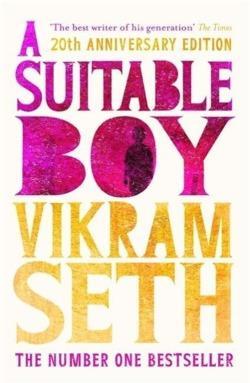English language
Suitable Boy
A Suitable Boy is a novel by Vikram Seth, published in 1993. With 1,349 pages (1,488 pages in paperback), the English-language book is one of the longest novels published in a single volume.A Suitable Boy is set in a newly post-independence, post-partition India. The novel follows four families during 18 months, and centres on Mrs. Rupa Mehra's efforts to arrange the marriage of her younger daughter, Lata, to a "suitable boy". Lata is a 19-year-old university student who refuses to be influenced by her domineering mother or opinionated brother, Arun. Her story revolves around the choice she is forced to make between her suitors Kabir, Haresh, and Amit. It begins in the fictional town of Brahmpur, located along the Ganges. Patna, Brahmpur, along with Calcutta, Delhi, Lucknow and other Indian cities, forms a colourful backdrop for the emerging stories. The novel alternately offers satirical and earnest examinations of national political …
A Suitable Boy is a novel by Vikram Seth, published in 1993. With 1,349 pages (1,488 pages in paperback), the English-language book is one of the longest novels published in a single volume.A Suitable Boy is set in a newly post-independence, post-partition India. The novel follows four families during 18 months, and centres on Mrs. Rupa Mehra's efforts to arrange the marriage of her younger daughter, Lata, to a "suitable boy". Lata is a 19-year-old university student who refuses to be influenced by her domineering mother or opinionated brother, Arun. Her story revolves around the choice she is forced to make between her suitors Kabir, Haresh, and Amit. It begins in the fictional town of Brahmpur, located along the Ganges. Patna, Brahmpur, along with Calcutta, Delhi, Lucknow and other Indian cities, forms a colourful backdrop for the emerging stories. The novel alternately offers satirical and earnest examinations of national political issues in the period leading up to the first post-Independence national election of 1952, including Hindu–Muslim strife, the status of lower caste peoples such as the jatav, land reforms and the eclipse of the feudal princes and landlords, academic affairs, abolition of the Zamindari system, family relations and a range of further issues of importance to the characters.The novel is divided into 19 parts, with each generally focusing on a different subplot. Each part is described in rhyming couplet form on the contents page.
